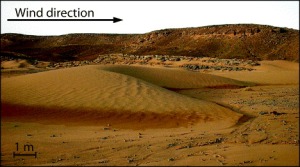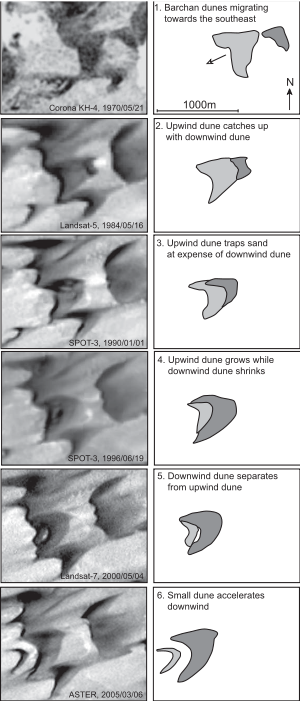The lowest region in Chad is known as the Bodélé Depression. Formerly part of Lake Chad before the growth of the Sahara Desert, this lowland area is full of the remains of single-celled algae known as diatoms, whose silicon cell walls form dunes of dust. Wind is strong and largely from a single direction, creating blinding storms of sand on a regular basis.

As I understand it from my limited geology knowledge, the sand in the Bodélé is a layer on top of harder ground, and the dunes form in crescent shapes known as barchans. These dunes can travel across the landscape, with speed depending on the size of the barchan: a large dune may only travel 30 meters in a year. However, observations from space over decades show that barchans in the Bodélé can maintain coherence for many years, so researchers can study their shapes and interactions.

Despite the ripples in sand dunes, they aren’t like water waves in most respects. The exceptions are the barchans, which seem to resemble solitary waves, also known as solitons. If you create a wave in the ocean (or any other body of water), it tends to disperse its energy: its crest lowers over time, and the wave grows wider until it merges with the average motion of the water around it. A wave formed in California typically won’t cross to Japan. Solitons are different: they are non-dispersive and can travel for long distances without losing energy. They form in canals and other narrow, shallow channels, where water is confined. However, the most famous solitons are tsunamis, waves generated from earthquakes. Tsunamis are notorious for propagating across oceans: even if their crests aren’t tall, because they carry so much energy from the original earthquake when they smash into land, they can drown whole coastlines.
While tsunamis are solitons, not all solitons are so destructive: it depends on the medium and of course the size of the wave. They show up in a wide variety of phenomena, and find use in optical communications: a pulse of light that doesn’t disperse over large distances is far more efficient than broad waves. Since barchan dunes keep their shapes over decades, perhaps they are like solitons. The real test is in how they interact: two solitons that collide pass through each other without breaking up, almost like particles do. (As you may guess, solitons find a place in particle physics for that reason.) The reason for all of this is that solitary waves are nonlinear: the total wave when you combine two solitons is not the sum of the two original waves.

Pieter Vermeesch of Birkbeck College in the University of London has shown that barchan collisions in the Bodélé are consistent with soliton-like behavior, based on decades of satellite observations. While the data resemble the results of numerical simulations, it’s important to note that the dust isn’t precisely like water: unlike waves passing through each other, the dunes actually transfer particles. When a smaller, faster-moving upwind barchan catches up with a larger, slower-moving dune, some of the sand is moved into the upwind barchan. Since the speed of a dune depends inversely on its size, the original upwind dune slows down, while the downwind dune speeds up as it loses dust flakes. In other words, rather than one dune passing through the other, they both change, but the result appears to be nearly the same. A smaller, faster-moving dune appears to pass through a larger, slower-moving dune, just as a smaller, faster-moving soliton passes through a larger, slower-moving soliton in a fluid medium.
Interestingly, this process appears only when the dunes are of comparable size: if the downwind dune is more than about 4 times the volume of the upwind dune, the barchans will either merge into one big dune, much as inelastic collisions stick two objects together (like a crash in which the two cars lock together), or fragment into a collection of smaller dunes. Vermeesch also considered oblique collisions, in which the smaller dune effectively replaces one horn of the larger dune, which is the result of the specific shape of the barchans. However, the effect is similar: once again, a smaller dune appears to pass through a larger dune, with a transfer of particles from one to the other to facilitate create the total system we see.
Dunes are not strictly waves, and barchan collisions are not strictly solitonic. However, when we get beyond the specific processes involved, both the physical and mathematical behaviors of these different systems appear alike. (I am curious about whether the masses of the barchans after the collisions are close to the original, which would make the interactions very particle-like. The available data is too incomplete to be sure.) As is so often in science, models in very different areas can teach us something new, where superficially it wouldn’t seem to be the case. With more data and analyses, scientists will know much better if a soliton-like model can describe barchans, and what exactly this analogy means for the physics of sand dynamics.
(Let the record show that I resisted the temptation to put a “t” on “sand” and “Sahara” in the title. I occasionally can control myself.)

10 responses to “Tsunamis of Sand in the Sahara”
[…] own Dune Week post: Tsunamis of Sand in the Sahara. Topographic map of the far side of the Moon, from Lunar Reconnaissance Orbiter data. Click the […]
Mathew,
Nice explanation. I live in Las Cruces New Mexico, not far from White Sands National Monument. “White sands” is a dune field of gypsum sand that gives its white color. It can be seen easily on any satellite map as the white splotch just above the westernmost tip of Texas. The dunes, typically 10 m high, begin in a lake west of the dunes and move easterly toward Alamagordo. Like the barchan dunes they move aver the flat ground at a predictable rate. Trees can grow quite high (10 m) in the space between dunes before the next dune begins covering them. If they grow fast enough, they can survive by having some leaves that still poke above the sand. If not they die leaving a carcass a few years later. If you go to 32.818 lat, -106.269 lon on Google Earth you’ll see what I mean.
Thanks, and very cool to see from satellite images! Hm, those may be barchans; do you know what they’re called geologically? They certainly look similar in shape, but I admit my ignorance about most of geology. Might be worth looking into a bit more.
Great post; I love the animation. It just puts me in mind of any other matter wave, water waves for instance. What happens when they collide? Nothing!
I liked this emergent dune meme so much I wrote a post too, on another physics-like aspect of dunes: morphological phase transitions.
I wonder if dunes ever exhibit linear wave behavior (like deep-channel water waves); I suspect not, even in places with a lot of sand. It’s an interesting problem to ponder.
Thanks for the link and the pingback! Great post!
In the top frame of the six-frame sequence, it says that the dunes are “migrating towards the southeast”. Am I missing something, or should that be “southwest”?
You’re asking at the wrong place: those images are from the original paper. It’s possible the images are reversed for whatever reason, or the author made an error in the label.
[…] “Tsunamis of Sand in the Sahara” and “Of Mobius Strips and the Shape of […]
[…] a Comment Barchan sand dunes on Mars, from Astronomy Picture of the Day. I wrote about barchans in the Sahara last […]
[…] barchan dune at White Sands National […]